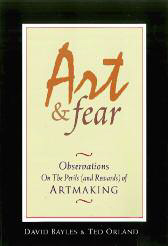Overcoming Fear

I was recently rummaging through my local bookstore, searching for the next pearl to unveil in this space, when I came across a book that stopped me in my tracks just because of its title: Art & Fear: Observations on the Perils (and Rewards) of Artmaking.
This slim, 122-page volume, written by David Bayles and Ted Orland (Capra Print Editions, 1993), is so provocative and insightful that I think I could fill a year’s worth of columns with my observations of how what they say ties into what we do as watershapers.
Keeping it brief, however, let’s begin by assuming that what watershapers do is an art form and therefore that we are artists – or are, at the very least, striving to become artists. In that sense, we share in challenges that are not so different from those faced by painters, photographers, musicians, dancers, writers, sculptors and practitioners of just about any other creative endeavor you might mention.
According to Bayles and Orland, the root, common issue that confronts everyone involved in creative pursuits has to do with overcoming fear. Indeed, their discussion spins off the simple observation that the toughest part of making any kind of art is getting started, and the reason for this difficulty is primarily the artist’s fear of failure.
To illustrate this point, the authors relate the story of a university-level ceramics instructor who conducted an experiment in which he told half his class that they would be graded strictly on the volume of their output and the other half that they would be graded on only a single project. The result? Many of those being graded on one project turned in nothing at all or incomplete work – with lots of obvious false starts included. By contrast, those working in volume turned in great profusions of work, and almost all of it was superior to the output of those who’d focused on just one object.
The idea here is that by removing the fear of failure for the multi-project students, the instructor had unleashed their creativity. By contrast, the other students for whom singular achievement was the goal were doomed to failure because perfection or even an approximation of it is elusive under so much pressure. The big point here, say the authors, is that creativity requires one to engage in the creative process over and over again, facing different variables and scenarios and, along the way, developing skills and problem-solving techniques. That, note Bayles and Orland, is how art and artists develop.
They go on to say that most would-be artists never make the grade, and it’s not because they lack talent but is instead because they stop trying. In many cases, in fact, those with the greatest aptitude, those who have an easier time getting started, are often the ones who pull up short when they encounter the first waves of resistance. By contrast, those who keep at it are the ones who eventually find success.
Turning to watershaping, we’re often told that to do volume work is not to do creative work. Weighing what I glean from this book, I would say that’s true when you deal exclusively with cookie-cutter projects and simply do the same thing over and over again. But now I’m left to wonder how anyone truly improves by pursuing only a small number of projects: Where the person using the same template time and time again might be driven by fear of trying anything new, the one who mulls over a single design for months on end opens himself or herself to creative paralysis resulting from fear of imperfection.
As I see it, the bottom line here is that we all need to strike a balance, doing work steadily enough to force us to hone our skills, while at the same time making certain it offers a variety of challenges that further polish what we do. On one hand, as the authors say, you need to avoid getting lost in a fantasy land where everything must be a work of pure imagination; on the other, you also need to avoid being an order taker who operates without creative outlets.
Both extremes can lead to fear-based failure, say Bayles and Orland, while success requires they we free ourselves from the shackles of fear and do what best suits our creative personalities. Sounds attainable to me.
Mike Farley is a landscape designer with more than 20 years of experience and is currently a designer/project manager for Claffey Pools in Southlake, Texas. A graduate of Genesis 3’s Level I Design School, he holds a degree in landscape architecture from Texas Tech University and has worked as a watershaper in both California and Texas.










